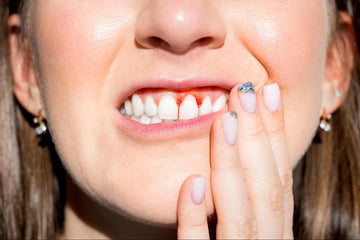Dental Floss 101: Helpful Tips for Cleaner and Healthier Teeth

Regular flossing has untold benefits for your teeth, gums and overall oral health.
But, many people find it challenging or uncomfortable, while others simply don’t know the proper techniques or know how to floss thoroughly.
Enlighten aims to make the seemingly well-kept secrets of flossing universally known. We’ve written a super handy guide on how to floss correctly, choosing the right floss and answering all the common questions you may have about it.
Why is flossing important?
Flossing isn’t an add-on to your routine that you should do when you feel like it — it should be as fundamental as brushing.
Flossing is vital to your oral health for many reasons, including the following:
1. Removes plaque: Flossing removes plaque — that sticky film that builds up between teeth and along the gum line — that an electric or manual toothbrush struggles to reach.
2. Prevents cavities: Flossing helps remove food, debris and plaque in hard-to-reach places. If left unchecked, plaque build-ups can harden, forming tartar and contributing to cavities, which flossing can prevent.
3. Reduces gum disease risk: Because flossing helps clear the teeth of all sorts of food and particulates, by default, it helps prevent gum disease too!
4. Improves breath: Trapped food between the teeth and around the gumline sets the stage for a whole host of bacterial growth. As bacteria grow, the smell worsens, so it’s important to get all of the debris out of your mouth’s hard-to-reach places using dental floss.
5. Maintains overall health: Gum disease has been linked to serious health issues like heart disease, diabetes, and respiratory problems — so why wouldn’t you go the extra mile and floss after you brush?
Flossing step-by-step
1. Pick your floss
Dental floss comes in many forms for different teeth. It can be difficult to know which one best suits your mouth, so consider these when making your decision.
· Thickness — Dental floss comes in different thicknesses, ranging from thin to thick. Thicker floss is better suited to those with wider gaps between their teeth, while thinner flosses work well for tighter spaces.
· Waxed vs Unwaxed — Waxed dental floss slides more easily between teeth due to its coating, but it might leave behind some residue. If you don’t want this, unwaxed dental floss provides a more natural feel, but bear in mind that it requires extra effort to manoeuvre around teeth that are close together.
· Flavoured Options — Many dental flosses come in various flavours, making for a more enjoyable floss. Choose a flavour that suits you.
2. How to floss
· Cut off approximately 18 to 24 inches of dental floss.
· Wrap most of the floss around your middle fingers, leaving about 1 to 2 inches of floss to work with.
· Hold the floss tightly using your thumbs and index fingers.
· Gently slide the floss between your teeth. Move it up and down, making sure to rub both sides of each tooth. Avoid forcing the floss into your gums to prevent injury.
· As the floss reaches your gums, curve it into a C shape at the base of each tooth to clean the space between the gum and tooth.
· Move to the next tooth and repeat the process, using a fresh section of floss each time.
How to floss if you have sensitive teeth
If you have sensitive teeth, you might give flossing a miss because it’s uncomfortable. Sensitive or not, your teeth still need flossing as part of a complete oral care routine.
However, there are ways you can make the process much less painful and aggravating on your gums. Some of these ways include:
Choosing a different floss
Floss is sometimes given a waxy coating that helps to reduce some of the abrasion and “sharpness” found in unwaxed flosses.
Alternatively, if you find yourself cutting your gums or irritating them, try a floss pick that’s typically easier to be gentle with than conventional floss.
If picking at your teeth is the cause of the irritation or inflammation, try a water flosser that uses a gentle stream of water to dislodge debris and particulates.
Interdental brushes and floss picks are also great for children. They help to remove any buildup of debris without cutting gums or hurting the mouth.
Use a desensitising toothpaste
Tubes of toothpaste containing potassium nitrate and hydroxyapatite can help numb the gum line before, during and after a deep floss. Enlighten Serum toothpaste is specially designed to help do just that - halting sensitivity in its tracks.
Using this toothpaste can reduce inflammation and sensitivity, letting those with even the most sensitive teeth floss without too much pain.
Change your rinsing routine
Instead of using a harsh mouthwash, which can aggravate small cuts in the gum or sensitive areas, try an alcohol-free mouthwash, which can help soothe before and after a flossing session.
To bring down some of the inflammation, try rinsing with some warm, salty water. Simply boil some water and wait for it to cool until it's warm to the touch and not too hot. Stir in half a teaspoon of salt, gargle and rinse.
How to floss your child’s teeth
Ideally, you should floss your child’s teeth when two or more of them touch – this is usually around age 2-3. Flossing a child’s teeth is very similar to flossing your own, but there are a few other things you need to bear in mind.
How to do it
· Take about 18 inches of floss and wrap most of it around your fingers, leaving about 1-2 inches to work with.
· Gently slide the floss between two teeth using a back-and-forth motion.
· Curve it into a “C” shape around each tooth and move it up and down to remove plaque and food particles.
· Avoid snapping the floss, as it can hurt their gums.
Remember that kids’ teeth and gums may be more sensitive, so be extra gentle to avoid hurting them.
Unfortunately, flossing isn’t usually a pleasant experience for young children – it’s up to you to make it fun and not a chore. Try to make it a game. You can sing songs, tell stories or reward them for a job well done.
Dreaming of a Brighter Smile? Choose Enlighten
Flossing is one of the key steps you can take to a fresher mouth and healthier teeth. However, to take it to the next level, it might be worth considering a professional whitening treatment.
Flossing is one of the key steps you can take to a fresher mouth and healthier teeth. However, to take it to the next level, it might be worth considering a professional whitening treatment.
At Enlighten, we know that every smile is unique and deserves personalised care. That’s why we offer a gentle, non-invasive whitening treatment designed to give you the radiant, confident smile you deserve.
Visit one of our certified dentists for a professional whitening treatment. Plus, explore our advanced Enlighten White toothpaste, specially formulated to protect against stains and reduce discolouration.
Curious to learn more? Browse our expert guides for the latest tips, advice, and insights on keeping your teeth bright and beautiful.
Frequently Asked Questions
1. How often should I floss?
You should floss at least once a day to remove plaque and food particles between teeth that brushing can’t reach. Flossing before bed helps prevent bacteria buildup overnight, leaving you with fresher breath and a healthier mouth in the morning.
2. Can you use mouthwash instead of dental floss?
Mouthwash is no substitute for flossing.
While mouthwash helps kill bacteria and freshen breath, it doesn’t remove plaque or food debris stuck between teeth — only floss can do this. However, don’t do one and not the other. Using both floss and mouthwash together is a great way to maintain oral health.
3. What should I do if my gums bleed while flossing?
If your gums bleed while flossing, don’t panic. You should:
· Keep flossing daily – Bleeding is often due to gum inflammation caused by plaque buildup. It usually improves with consistent flossing and cleaning.
· Be gentle – Avoid snapping floss into the gums. Use a slow, gentle gliding motion.
· Use a softer floss – Waxed or tape floss can be gentler on sensitive gums.
· Check for underlying issues – If bleeding continues after a couple of weeks, see a dentist to rule out gingivitis or gum disease.
4. Can I reuse dental floss?
No, dental floss should not be reused.
Once used, floss becomes frayed and weakened, making it less effective at removing plaque. It also collects bacteria, which can be reintroduced into your mouth. Always use a fresh piece of floss each time.
› DIG DEEPER ‹
![]()
Learn more about the Enlighten Teeth Whitening System HERE.
And to find an Enlighten whitening expert near you, hit the link below.
FIND A DENTIST

Or if it’s mini smile makeovers you want to dig deeper into, then give it a click right HERE.
_________________________________________________________________________





